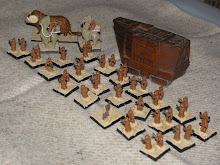Recently played a game of CD3 with a friend of mine, Mr K. the game was to be set in Italy in 1944, and was to be a small battle between a battalion of US infantry, and a battalion of RSI infantry. As the game progressed, each side would have access to small company sized groups of reinforcements. These reinforcements would take 1 to 3 turns to arrive (1d6, 1,2 = 1 turn, 3,4 = 2 turns, 5,6 = 3 turns.) This process would start with the first Axis encounter with the US forces, happen again when US forces encounter the Axis reinforcements, and so forth. we decided to do it this way because we wanted to try it out as a mechanism for feeding in new units into a game.
 |
| The kitchen table awaits.... |
We decided on a small setup of some roads, a woods, and a BUA consisting of the ruins of St Domino's Monastery. the Italian forces would be defending the area for a possible Allied advance.
 |
| Another view, this time towards the fridge. |
RSI Infantry Battalion - Troop Quality: Regular, Morale: 7.
HQ Company w/
1 Command stand
2 Support stands
3 Infantry Companies, each w/
3 Infantry stands
The above TOE was based on the 1943 Italian Infantry battion TOE given in 'Armies of the Second World War' - note that the troop quality has increased one grade, and the morale has increased one point. My justification for this was twofold, firstly for game balance, and secondly to reflect that, initially at least, RSI troops had 'better' morale and training under the German reorganization of Italian forces. With their usage as primarily anti partisan and garrison troops, morale did drop, and desertion did increase, so I would be reluctant to give those ratings across the board in 1944 - but for one small unit in a fictional battle, I am happy to do so.
 |
| Esci Italian pack Mules... surely you mean, Esci Italian Support Stands. |
 |
| The first company deploys along the treeline. |
 |
| The other two companies deploy in the Monastery. |
His TOE was:
1944 US Infantry Battalion - Troop Quality: Regular, Morale: 8
Headquarters, w/
1 Command stand
1 Jeep
Headquarters Company w/
1 Command stand
1 Jeep
2 Bazooka stands
3 Rifle Companies, w/
1 Command stand
1 Weapons stand
3 Infantry stands
Heavy Weapons Company, w/
1 Command stand
1 Jeep
1 81mm Mortar stand
2 MMG stands
So to begin with, my forces were outnumbered, but I had two major advantages; firstly that I was defending, and secondly, that I would be receiving the first reinforcements.
 |
| US Heavy weapons Company started the game across from my deployment in the woods. |
 |
| More US Infantry ready to advance. |
 |
| US infantry ready to advance into the woods. |
 |
| Hit, forced back, and pinned! |
 |
| And some more of the same! |









































